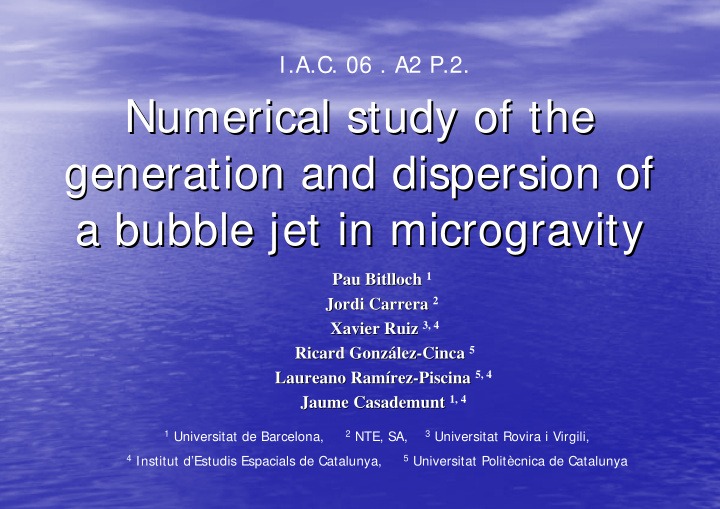



I.A.C. 06 . A2 P.2. Numerical study study of of the the Numerical generation and and dispersion dispersion of of generation a bubble bubble jet in jet in microgravity microgravity a Pau Bitlloch 1 Pau Bitlloch Jordi Carrera 2 Jordi Carrera Xavier Ruiz 3, 4 Xavier Ruiz Cinca 5 Ricard Gonzá Ricard Gonz ález lez- -Cinca Piscina 5, 4 Laureano Ram Ramí írez rez- -Piscina Laureano Jaume Casademunt 1, 4 Jaume Casademunt 1 Universitat de Barcelona, 2 NTE, SA, 3 Universitat Rovira i Virgili, 4 Institut d’Estudis Espacials de Catalunya, 5 Universitat Politècnica de Catalunya
Previous experimental Bremen Drop Tower campaign Recently, a first series of drop tower experiments was conducted, which proved the excellent performance of a new method of generation of monodisperse microbubble suspensions in microgravity Results are relevant for a large variety of systems which may exploit the enhanced efficiency of biphase flows in space technology. The experimental system allows also to address a number of basic questions concerning the collective dynamics of bubbles. Dropping height =119 m Compensated gravity time = 4.74 s Residual accelerations = 10 -5 to 10 -6 g E Vacuum pressure < 10 Pa Normal Gravity µg, t = 0.24 s µg, t = 0.76 s Deceleration levels = 25 - 35 g ° (200 ms) Drop number 1: Q l = 0.69 ml / s, Q g = 0.27 ml / s
Theoretical approach We represent the turbulences using the standard k- ε model The dispersion of bubbles are represented with a scalar magnitude P (the probability density of bubbles) wich is diffused within the jet by means of a diffusivity factor of the same magnitude than that of k Standard k- ε model Contours levels of k 2 / ε for the turbulent jet Probability density P of bubbles Contour levels of bubble probability density in logarithmic scale for a longitudinal section of the jet
Results and Conclusions Good qualitative agreement with experimental results Probability density of bubbles Numerical results show that nonhomogeneous diffusivity is necessary to have realistic patterns of bubble dispersion. We also find that the local diffusivity of bubbles is of the order of that of the kinetic energy of turbulences, which scales as k 2 / ε , and that diffusion and advection are quantitatively comparable. Comparison of P for a vertical section at x=3cm with We conclude that the proposed stochastic model for bubble dispersion based on the k- ε model of different treatment of the effective diffusion of bubbles, either homogeneous values or proportional to k 2 / ε turbulence with local diffusivity is a proper description of experiments.
Recommend
More recommend